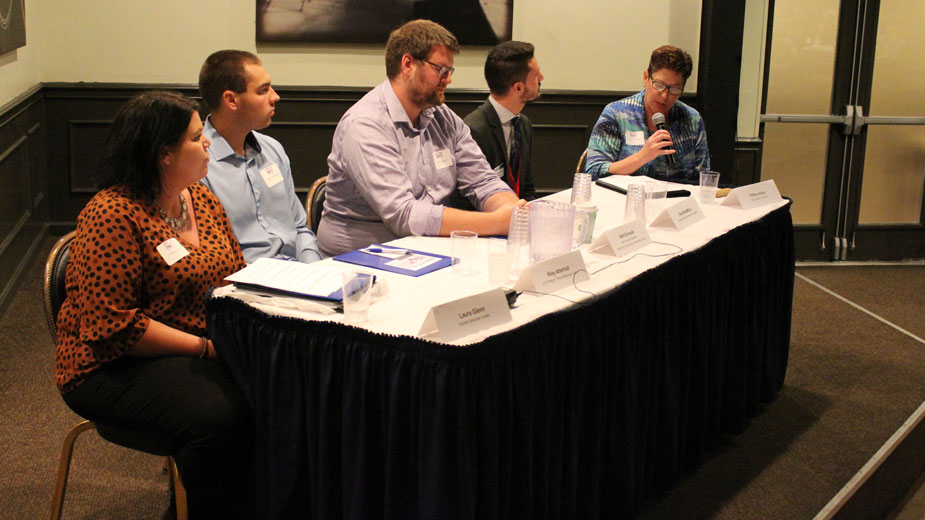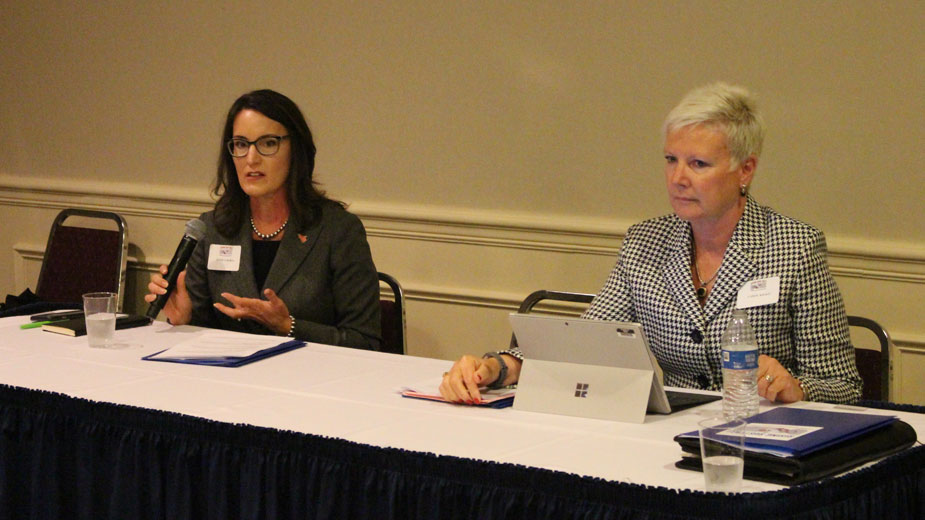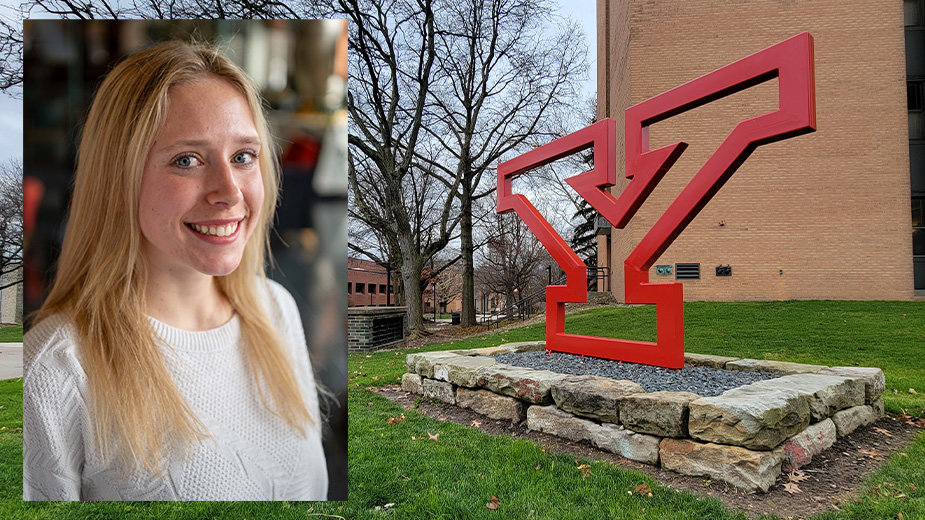How to Attract and Keep Young Professionals Here
WEST MIDDLESEX, Pa. — As former mayor of a city that lost nearly “everything that made our community a community,” Pennsylvania Lt. Gov. John Fetterman understands the value of retaining young talent.
So, when Dustin McGaughey, a senior at Sharpsville High School who is enrolled at eCenter@LindenPointe, asked Fetterman Oct. 7 at the Rising Rust Belt summit if there was “anything you wish you would have known” when he was about to graduate from high school, Fetterman’s response was he wished he and others knew the importance of returning after leaving the area and gaining new skills.
But, he added, doing so requires creating a welcoming environment for young people and to keep an open mind as to what’s important to the next generation.
“Retaining young people is critical,” he said. “But you’re not going to force a young person to stay.”
McGaughey was one of 25 eCenter students from 11 school districts at the summit, brought by Lisa Evans, eCenter program director, and coordinator Debbie Anderson. Events such as Rising Rust Belt are important to fostering and retaining young people who need to feel connected to the business community, Evans said.
Attracting and retaining the next generation of workers was a hot topic throughout the event. During a discussion on the subject, panelists cited common variables that keep them local, including family, community amenities, low cost of living and proximity to Pittsburgh and Cleveland. However, attracting workers is one thing; the onus is on the employer to keep them here.
The director of program planning and development at the Human Services Center in Lawrence County, Laura Glenn, said she wants to work for a company that values her development. She cautioned employers that younger generations aren’t “married” to their jobs as previous generations were and will leave if a company abandons its values or provides no opportunity to advance.
“We’re no longer job hunting when you’re jobless,” Glenn said. “Most people are job hunting in your offices during their breaks.”
While Glenn returned to the area because of family, she said she stays because her employer has given her room to grow, with several promotions in the 12 years she’s worked there.

One aspect is giving employees an opportunity to buy in, said fellow panelist Shea MacMillan, manager of business development at the Youngstown/Warren Regional Chamber. That includes being flexible and open-minded when younger employees bring new ideas, he said.
“It’s always great when you let them know that their opinions are valued when you’re making company decisions,” MacMillan said. “That makes you feel like you’re a part of something more than just showing up 8-to-5 and collecting a paycheck.”
When he saw an opportunity to leverage the area’s rail access to retain industrial businesses and help them generate new revenue, the chamber gave him the opportunity to expand his focus, he said. Rail wasn’t part of the core functions of the chamber, he said, but it paralleled with his work. “Then ultimately, we brought it into our umbrella,” he said.
Other ideas shared by the panel included having health-care benefits, focusing on work-life balance and maintaining a positive workplace culture.
A desire for opportunity was one of the most common needs Paige Nealer heard from young professionals during the summit, along with community amenities, she said. Nealer, director of marketing and advertising with The Nugent Group, was on hand to represent Thrive Shenango Valley, a young-professionals group that started about three months ago. The group meets with high school graduates and college students to see what they want in a community.
“Growth opportunities are really big, especially with businesses. People don’t want to stay in these entry level jobs,” Nealer said. “We’re trying to connect them with businesses so they can get that growth, get that mentorship and move up the ladder.”
Industry and educational entities recognize those needs and are working to meet them, while also establishing pathways for individuals to work the jobs that are available in the region.
Through sector partnerships with employers in a common industry, the Mahoning Valley Manufacturers Coalition identifies their needs and similarities and connects them with other economic development and educational entities to try to solve the problems, said its executive director, Jessica Borza, during a panel on workforce development.
“Nine times out of 10, 80% of their needs are similar,” Borza said. “When the manufacturers realize that, some light bulbs go on. They really like the idea of working more efficiently with, what oftentimes are their competitors, to be able to engage a system of partners instead of just one by one going out and sitting on advisory boards.”
In Pennsylvania, the Department of Community and Economic Development is forming Next Generation Industry Partnerships, which are led completely by the private sector, said Carol Kilko, deputy secretary for business financing. While the service providers and educational institutions are at the table, industry and businesses work toward the implementation, she said.
“Programs, they come and they go,” Kilko said. “And why do they come? Because there’s funding. Why do they go? Because there isn’t any funding left. And for us to be able to sustain these kinds of partnerships, there has to be relevancy to the private sector.”

While the skills gap is an issue, the bigger pain point is “a people gap,” with not enough people to train, Kilko said. To address the issue, businesses involved in the partnerships are developing a promotional plan to talk about the region and why people should move to the area to live, work and play, she said.
To address the need for opportunities, companies are coming up with innovative ways to attract and develop new hires while advancing the ones they already employ, Borza added. In the 14-county Oh-Penn Interstate Region, the MVMC promotes accelerated apprenticeships focused on competency rather than the traditional, time-based apprenticeships.
“When you start your apprenticeship program, maybe you already know stuff,” Borza said. “Well, let’s make sure you get credit for that and you don’t have to redo those hours or that classroom training.”
To get students interested in the skilled trades, however, the dialogue in the area must change, said Tony Miller, administrative director of the Mercer County Career Center, during a panel discussion on the topic.
For the last 40 years, the sales pitch has been to go to college after high school, when it should have been “What are you doing next?” Miller argued.
To increase career-awareness opportunities among students, Pennsylvania has mandated students must show evidence that they’ve become aware of a career during their education – such as completing a job shadow or earning an industry credential – and school districts must prove that students have accumulated 20 of these “career artifacts” by the time they graduate from high school.
In Mercer County, leadership has worked these career standards into guidance-counseling plans to supplement the growing number of tours at career centers and area industry, “and that’s been a good thing,” Miller said.
Along with the career awareness for students, parents and community members must encourage students to pursue those careers, said Len Rich, superintendent of the Laurel School District and administrative director for Lawrence County Career and Technical Center. The skilled trades allow students to transition right out of high school to a job, so they can start earning a paycheck without incurring student loan debt, he said.
“I find it ironic that we see this situation where there are 3 to 4 million skilled-trades jobs open across the United States today and they will remain unfilled,” Rich said. “But we have parents investing tens of thousands of dollars per summer, per child in travel athletics to get a scholarship.
“You’ve got to travel to your nearest union hall and you will get a scholarship,” he continued. “We have to spread the gospel one communication at a time. And that could be with a parent. That could be with a student. And that needs to go beyond the choir.”
The characteristics that attract and retain workers do the same for entrepreneurs, though experts say more needs to be done in that regard as well.
In the immediate area, the state of entrepreneurship is “not as high as we’d like,” said Jim Cossler, Huntington Bank Entrepreneur-in-Residence with the Youngstown Business Incubator. One reason for that, he said, is a lack of resources, which is why 12 years ago the YBI started building a diaspora network of investors, venture capitalists and other resources and continues to work on it today.
“That mentors our companies. That opens doors for our companies,” he said.
The YBI works to create a “hypercooperative cluster of talent,” Cossler said. This is crucial for fostering an entrepreneur-friendly area because, rather than graduating its companies, the YBI moves them from incubation to acceleration to making them commercial tenants or finding them real estate in downtown Youngstown, he said.
Cossler set guidelines to ensure hypercooperation, including not hiring someone else’s employee, not stealing someone else’s idea, and the most important: “We expect you to give back to the two-person startup that follows you through the door,” he said.
The eCenter’s Evans said finding available commercial real estate and talent is difficult for businesses coming out of incubation at the eCenter and are looking to scale.
“We have empty buildings, but they need remodeled or they need something done and it just costs so much that they can’t afford to do that,” she said.
Evans echoed sentiments made by others throughout the day of connecting young people to the community. A majority of her constituents are 17 and 18 years old and “they just want somewhere to belong,” she said. “If they have a place where they feel like they matter, that they’re connected to, they’ll stay.”
Copyright 2024 The Business Journal, Youngstown, Ohio.


